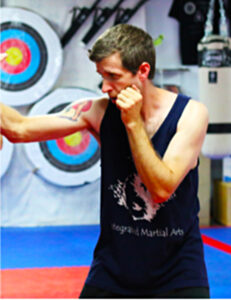
Arlo Welty – showing basic striking.
By Arlo Welty
–
When teaching self-defense, we must ask ourselves “What is the probability of this technique or concept working in a fight with limited training?” versus asking “It is possible the technique or concept will work after lots of training. Techniques and concepts that are possible become more probable with proper training and proper repetition. So what should we teach beginners that want to learn self- defense? This is something that each instructor must decide for their own school or class.
I would rather teach a handful of techniques and concepts that can be applied to dozens of different attacks, than dozens of techniques and concepts that can only be used in one type of an attack. Some techniques rely on muscle, which puts the defender at a disadvantage if they are not the same size or larger than their attacker. Discuss size appropriate techniques and concepts, because not everyone can pick up their attacker. Teach for short students as well as for tall students, both have their advantages and disadvantages. Teach the more complicated techniques and concepts to the advanced students who have a good foundation on which to increase the effectiveness of the technique or concept. Don’t let fantasy get in the way of good self-defense. Everyone catches punches and grabs the arm in the movie, but try catching a skilled striker’s arm mid-punch in real life and see what happens. I’ll be the first to admit that joint locking is not practical without years and years of practice and practical application. Even then, my attacker has to feed the proper energy to facilitate the application of the lock. I have to plan on the lock failing and have a good exit into striking, kicking or grappling. I teach my students to ground fight, but I warn them about taking a fight to the ground. Staying mobile and aware of your surroundings is difficult while on the ground, especially when the fight is taking place in public where they might have friends ready to jump in and fight. Don’t get into the movie mindset and forget about what really counts, which is getting home safe.
Run away whenever possible so you don’t have to rely on your martial arts training. Your ego is easier to heal than your body. I never advocate fighting when there are other options. Even the greatest fighters in the world make mistakes and lose fights on the street and in the ring. We train for the moments when we can’t run and we hope that our training is sufficient. The repetitions (fighting and running) are what allow us to build muscle memory and give us a better opportunity for success in a real fight.
Without the correct timing, accuracy and proper form, a technique isn’t field ready until you master the application. First, we start with a compliant partner that allows us train the form with great repetition. Second, we need our partner to contest the technique so we can fine tune it and work on timing. The last step is to compete in sparring (light contact or hard contact) to find proper timing, accuracy, form and placement of the technique. Refining one’s own technique leads to better instruction and proper fighting concepts.
Never stop learning, never stop improving.
